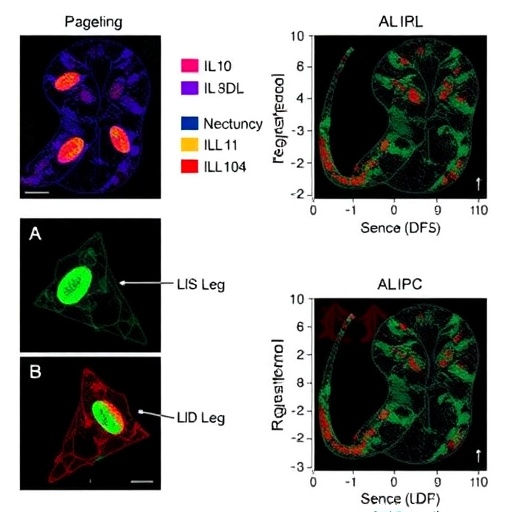Gene signature may allow clinicians to better stratify patients and reduce treatment intensity to lower side effects

Credit: MD Anderson Cancer Center
HOUSTON – By analyzing variations in the level of human papillomavirus (HPV) in head and neck cancers, researchers at The University of Texas MD Anderson Cancer Center have discovered a gene signature associated with treatment response and survival in patients. Rather than simply classifying tumors as HPV-positive or HPV-negative, this biomarker may one day enable clinicians to better predict patient outcomes, ultimately allowing for reduced treatment intensity to minimize severe side effects.
The study, published today in JCI Insight, identified a subset of patients with HPV-positive head and neck, or oropharyngeal, cancers with a molecular profile and survival rates similar to HPV-negative cancers, which typically have poor outcomes. The researchers discovered a gene panel that distinguished this subgroup and appeared predictive of outcome in multiple independent cohorts.
According to the Centers for Disease Control and Prevention (CDC), more than 18,000 cases of oropharyngeal cancer are diagnosed each year in the U.S., with HPV infection responsible for roughly 70 percent of all cases.
Standard care for HPV-positive oropharyngeal cancers is a combination of chemotherapy and radiation with a five-year survival rate of approximately 85 percent, compared to just 55 percent for HPV-negative cancers, explained Curtis Pickering, Ph.D., assistant professor of Head and Neck Surgery and corresponding author on the study.
“Patients with HPV-positive oropharyngeal tumors are living a long time after radiation treatment, but often are left with significant long-term morbidity, including problems with speech or swallowing,” said Pickering. “Therefore, there’s a desire among clinicians to reduce, or de-escalate, therapy to lessen severe side effects. However, we currently don’t have good biomarkers to safely determine which patients are candidates for de-escalation.”
To better understand the role of HPV biology in patient outcome and identify biomarkers associated with treatment response, the research team analyzed data from 80 oropharyngeal cancers included in The Cancer Genome Atlas (TCGA). Rather than simply classifying tumors as HPV-positive or HPV-negative, the researchers examined all tumors based on their level of HPV gene expression.
“That led us to an expression signature that neatly identified two different groups within the HPV-positive patients,” said Pickering. “The HPV-negative tumors were clearly different, but within HPV-positive there were two different groups. That was biologically interesting, but one HPV-positive subgroup had survival similar to those of HPV-negative patients.”
The researchers found an initial panel of 582 genes that distinguished these three subgroups — a high HPV group, a low HPV group and an HPV-negative group — each with statistically significant survival differences. Further analyses led to a panel of just 38 genes that are able to distinguish between the two HPV-positive subgroups.
A variety of genetic analyses confirmed the distinction between these groups, and the researchers discovered two viral genes not generally thought to be important for tumor progression that were significantly different between the HPV-positive groups. Further, cell line studies showed these genes to be correlated with radiation sensitivity, in alignment with responses seen in patients.
Recognizing the potential value of this gene signature for predicting treatment response, the researchers evaluated the biomarker in two independent patient cohorts of HPV-related oropharyngeal and cervical cancers. In each case, the gene panel appeared to be prognostic of survival and performed better than available clinical factors, such as smoking status and tumor size. After further refining their gene panel, the researchers believe that the biomarker could be reduced to as small as a single gene with similar prognostic ability.
“What I’m hoping is we’ve found some new fundamental aspects of HPV biology related to the carcinogenic process, the progression of the tumor and response to therapy,” said Pickering. “If we’re able to validate this in future studies, it could be incredibly clinically useful across several HPV-related tumor types.”
The current retrospective study was limited by relatively small cohort sizes and reliance on RNA sequencing data; therefore the research team hopes to evaluate their biomarker in prospective trials after developing an assay sufficient for clinical use.
###
The study was supported by the National Institutes of Health (UL1TR001442); the National Cancer Institute (P30CA016672); and the HPV-Related Cancers Moon Shot™, part of MD Anderson’s Moon Shots Program™, a collaborative effort to accelerate the development of scientific discoveries into clinical advances that save patients’ lives. The authors have declared that no conflict of interest exists.
In addition to Pickering, other MD Anderson authors on the study include: Frederico Gleber-Netto, D.D.S., Ph.D., Meng Gao, Ph.D., Kelly Erikson, and Jeffrey Myers, M.D., Ph.D., all of Head and Neck Surgery; Xiayu Rao, Yuanxin Xi, Ph.D., Li Shen, and Jing Wang, Ph.D., all of Bioinformatics and Computational Biology; Nene Kalu, Ph.D., Keiko Akagi, Ph.D., Maura Gillison, M.D., Ph.D., and Faye Johnson, M.D., Ph.D., all of Thoracic/Head & Neck Medical Oncology; and Heath Skinner, M.D., Ph.D., of Radiation Oncology. Additional authors include: Theresa Guo, M.D., Johns Hopkins Medical Institutions, Baltimore, MD; Shuling Ren, Guorong Xu, Ph.D., and Joseph Califano, M.D., UC San Diego Moores Cancer Center, San Diego, CA; Kathleen Fisch, Ph.D., University of California San Diego, La Jolla, CA; Tanguy Seiwert, M.D., University of Chicago, Chicago, IL; and Mitchell Frederick, Ph.D., Baylor College of Medicine, Houston, TX.
Media Contact
Clayton Boldt
[email protected]
713-792-9518




